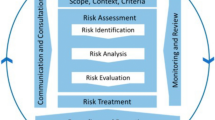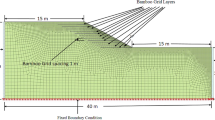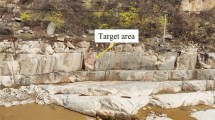Abstract
Rockfall events are a common geological hazard in the mountain areas of western China and frequently occur on unstable slopes. The purpose of this study was to establish a statistical model of random rockfall–slope collision using the impulse moment theorem considering that the impacted stones are moving. The rebound velocity of rockfall is random because the microstructure of the ground and slope can be described with statistical properties. The analytical solutions of the rebound particles are obtained as formulas for the incident velocity, incident angle, impacted rock movement, slope angle, and ground surface microstructure. The means and standard deviations of rebound velocity are fitted with slope angle to calculate formulas based on probability theory, which agrees with the previous results. The probability distribution functions of the horizontal distance and vertical distance follow a Gaussian distribution and a negative exponential distribution under the given slope angle, respectively. A formula of trajectory is also given.








Similar content being viewed by others
Data availability
Data availability regarding this study should be obtained from the corresponding author.
References
Chattopadhyay S, Saxena R (1991) Combined effects of shear deformation and permanent indentation on the impact response of elastic plates. Int J Solids Struct 27:1739–1745. https://doi.org/10.1016/0020-7683(91)90072-N
Chau KT, Wong RHC, Wu JJ (2002) Coefficient of restitution and rotational motions of rockfall impacts. Int J Rock Mech Min Sci 39:69–77. https://doi.org/10.1016/S1365-1609(02)00016-3
Chen Z, Yang P, Liu H, Zhang W, Wu C (2019) Characteristics analysis of granular landslide using shaking table model test. Soil Dyn Earthq Eng 126:105761. https://doi.org/10.1016/j.soildyn.2019.105761
Chen L, Zhang W, Chen F, Gu D, Wang L, Wang Z (2022) Probabilistic assessment of slope failure considering anisotropic spatial variability of soil properties. Geosci Front 13:101371. https://doi.org/10.1016/j.gsf.2022.101371
Cui S-H, Pei X-J, Huang R-Q (2017) Rolling motion behavior of rockfall on gentle slope: an experimental approach. J Mt Sci 14:1550–1562. https://doi.org/10.1007/s11629-016-4144-7
Dorren LKA, Maier B, Putters US, Seijmonsbergen AC (2004) Combining field and modelling techniques to assess rockfall dynamics on a protection forest hillslope in the European Alps. Geomorphology 57:151–167. https://doi.org/10.1016/S0169-555X(03)00100-4
Ferrari F, Giacomini A, Thoeni K (2016) Qualitative rockfall hazard assessment: a comprehensive review of current practices. Rock Mech Rock Eng 49:2865–2922. https://doi.org/10.1007/s00603-016-0918-z
Gu X, Wang L, Ou Q, Zhang W (2023) Efficient stochastic analysis of unsaturated slopes subjected to various rainfall intensities and patterns. Geosci Front 14:101490. https://doi.org/10.1016/j.gsf.2022.101490
He S, Wu Y, Yang X (2008) Study of rock-fall motion on slope. Chin J Rock Mech Eng 27:2793–2798
He S, Wu Y, Li X (2009) Research on restitution coefficient of rock fall. Rock Soil Mech 30:623–627
He SM, Wang DP, Yong WU, Ouyang CJ (2014) Formation mechanism and key prevention technology of rockfalls. Chin J Nat 36:336–345
Hu J, Li S, Shi S, Li L, Zhang Q, Liu H, He P (2018) Experimental study on parameters affecting the runout range of rockfall. Adv Civ Eng 2018:4739092. https://doi.org/10.1155/2018/4739092
Huang R, Liu W, Zhou J, Pei X (2010) Experimental field study of movement charateristics of rock blocks falling down a slope. J Earth Sci 21:330–339. https://doi.org/10.1007/s12583-010-0096-y
Labiouse V, Descoeudres F, Montani S (1996) Experimental study of rock sheds impacted by rock blocks. Struct Eng Int 6:171–176. https://doi.org/10.2749/101686696780495536
Liao X, Wang X, Li L, Liu H, Yang Z, Chen Z (2020) Engineering application and prediction of the influence area of the rockfall hazards. Math Probl Eng 2020:1067215. https://doi.org/10.1155/2020/1067215
Liu G, Li J (2019) A three-dimensional discontinuous deformation analysis method for investigating the effect of slope geometrical characteristics on rockfall behaviors. Int J Comput Methods 16:1850122. https://doi.org/10.1142/S0219876218501220
Mougin JP, Perrotin P, Mommessin M, Tonnelo J, Agbossou A (2005) Rock fall impact on reinforced concrete slab: an experimental approach. Int J Impact Eng 31:169–183. https://doi.org/10.1016/j.ijimpeng.2003.11.005
Naito N, Maeda K, Konno H, Ushiwatari Y, Suzuki K, Kawase R (2020) Rockfall impacts on sand cushions with different soil mechanical characteristics using discrete element method. Soils Found 60:384–397. https://doi.org/10.1016/j.sandf.2020.02.008
Nakajima S, Abe K, Shinoda M, Nakamura S, Nakamura H (2021) Experimental study on impact force due to collision of rockfall and sliding soil mass caused by seismic slope failure. Landslides 18:195–216. https://doi.org/10.1007/s10346-020-01461-z
Oger L, Ammi M, Valance A, Belad**e D (2005) Discrete element method studies of the collision of one rapid sphere on 2D and 3D packings. Eur Phys J E 17:467–476. https://doi.org/10.1140/epje/i2005-10022-x
Pei XJ, Huang RQ, Pei Z, Dong XJ (2011) Analysis on the movement characteristics of rolling rock on slope caused by insensitive earthquake. J Eng Geol 19:498–504
Pei X, Luo J, Huang R (2019) Failure mechanisms of wind-induced post-seismic rockfall hazard. Bull Eng Geol Environ 78:5707–5725. https://doi.org/10.1007/s10064-019-01509-y
Plantard G, Papini M (2005) Mechanical and electrical behaviors of polymer particles. Experimental study of the contact area between two particles. Experimental validation of a numerical model. Granul Matter 7:1–12. https://doi.org/10.1007/s10035-004-0194-6
Qing LU, Sun H, Zhai S, Wang H, Shang Y (2003) Evaluation models of rockfall trajectory. J Nat Disasters 12:79–84
Scavia C, Barbero M, Castelli M, Marchelli M, Peila D, Torsello G, Vallero G (2020) Evaluating rockfall risk: some critical aspects. Geosciences 10:98. https://doi.org/10.3390/geosciences10030098
Shen W, Zhao T, Dai F (2021) Influence of particle size on the buffering efficiency of soil cushion layer against rockfall impact. Nat Hazards 108:1469–1488. https://doi.org/10.1007/s11069-021-04741-6
Shen W, Zhao T, Dai F, Jiang M, Zhou GGD (2019) DEM analyses of rock block shape effect on the response of rockfall impact against a soil buffering layer. Eng Geol 249:60–70. https://doi.org/10.1016/j.enggeo.2018.12.011
Singh AK, Kundu J, Sarkar K, Verma HK, Singh PK (2021) Impact of rock block characteristics on rockfall hazard and its implications for rockfall protection strategies along Himalayan highways: a case study. Bull Eng Geol Environ 80:5347–5368. https://doi.org/10.1007/s10064-021-02288-1
Sun CT (1977) An analytical method for evaluation of impact damage energy of laminated composites. ASTM Spéc Tech Publ. https://doi.org/10.1520/STP26958S
Tang J, Zhou X, Liang K, Lai Y, Zhou G, Tan J (2021) Experimental study on the coefficient of restitution for the rotational sphere rockfall. Environ Earth Sci 80:419. https://doi.org/10.1007/s12665-021-09684-6
Wang D, Liu Y, Pei X, Shi S (2016) Elasto-plastic dynamic responses of reinforced concrete slabs under rockfall impact. J Southwest Jiaotong Univ 51:1147–1153
Wang Y, Jiang W, Cheng S, Song P, Mao C (2018) Effects of the impact angle on the coefficient of restitution in rockfall analysis based on a medium-scale laboratory test. Nat Hazards Earth Syst Sci 18:3045–3061. https://doi.org/10.5194/nhess-18-3045-2018
**e L, Zheng X-J, Zhou Y (2003) A theoretical study of the distribution of the initial velocity of saltating sand particles by collision. Key Eng Mat 243–244:613–618. https://doi.org/10.4028/www.scientific.net/KEM.243-244.613
Zhang G, **ang X, Tang HM (2011) Field test and numerical calculation of rockfall collision restoration coefficient. Chin J Rock Mech Eng 30:1266–1273
Zhang S-L, Yang X-G, Zhou J-W (2018) A theoretical model for the estimation of maximum impact force from a rockfall based on contact theory. J Mt Sci 15:430–443. https://doi.org/10.1007/s11629-017-4606-6
Zhang Z, Zheng L, Deng J, Yao H, Tu Y, Luo J, Bai Y (2017) Rockfall simulation with consideration of Multi-blocks using 3-D DDA. Adv Eng Sci 49:112–118. https://doi.org/10.15961/j.jsuese.201600951
Zhang J, Wang R, Han W, Bao H (2022) A comprehensive approach for bridge performance evaluation under rockfall impact integrated with geological hazard analysis. Eng Fail Anal 141:106668. https://doi.org/10.1016/j.engfailanal.2022.106668
Zhao R, Tao M, Wu C, Li X, Wang S (2022) Study on size and load rate effect of dynamic fragmentation and mechanical properties of marble sphere. Eng Fail Anal 142:106814. https://doi.org/10.1016/j.engfailanal.2022.106814
Zheng XJ, **e L, Zhou Y-H (2005) Exploration of probability distribution of velocities of saltating sand particles based on the stochastic particle–bed collisions. Phys Lett A 341:107–118. https://doi.org/10.1016/j.physleta.2005.04.084
Zhu C, Wang D, **a X, Tao Z, He M, Cao C (2018) The effects of gravel cushion particle size and thickness on the coefficient of restitution in rockfall impacts. Nat Hazards Earth Syst Sci 18:1811–1823. https://doi.org/10.5194/nhess-18-1811-2018
Acknowledgements
This study was supported by the National Natural Science Foundation of China (Grant no. 12262021). The authors would like to express their sincere appreciation for this support.
Funding
This study was supported by the National Natural Science Foundation of China (Grant no. 12262021).
Author information
Authors and Affiliations
Contributions
S-ZD contributed to conceptualization, methodology, funding acquisition, and writing—original draft. G-LL provided software and was involved in data curation, validation, formal analysis, and writing—review and editing. XY contributed to investigation, data curation, project administration, and visualization. X-RW provided software was involved in data curation and project administration.
Corresponding author
Ethics declarations
Conflict of interest
The authors declare that they have no known competing financial interests or personal relationships that could have appeared to influence the work reported in this paper.
Additional information
Publisher's Note
Springer Nature remains neutral with regard to jurisdictional claims in published maps and institutional affiliations.
Rights and permissions
Springer Nature or its licensor (e.g. a society or other partner) holds exclusive rights to this article under a publishing agreement with the author(s) or other rightsholder(s); author self-archiving of the accepted manuscript version of this article is solely governed by the terms of such publishing agreement and applicable law.
About this article
Cite this article
Duan, SZ., Li, GL., Yang, X. et al. Predicting the velocity and trajectory of a rockfall after collision considering the effects of slope properties. Nat Hazards 120, 2057–2072 (2024). https://doi.org/10.1007/s11069-023-06278-2
Received:
Accepted:
Published:
Issue Date:
DOI: https://doi.org/10.1007/s11069-023-06278-2




